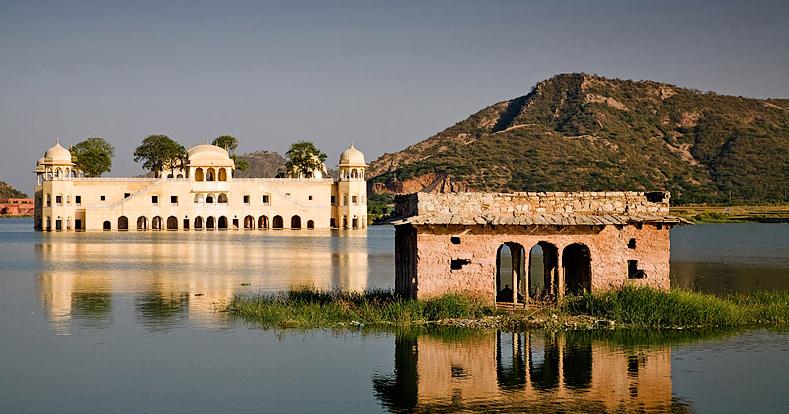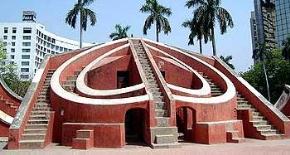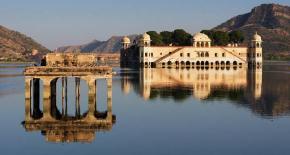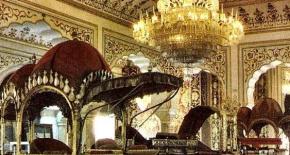
Founded in AD 1727 by Sawai Jaisingh II, Jaipur the capital of Rajasthan is popularly known as the Pink City with broad avenues and spacious gardens. The capital of Rajasthan, Jaipur is steeped in history and culture. Here the past comes alive in magnificent forts and palaces, blushed pink, where once lived the maharajas. The bustling bazaars of Jaipur, famous for Rajasthani jewellery, fabric and shoes, possess a timeless quality and are surely a treasure-trove for the shoppers. This fascinating city with its romantic charm takes you to an epoch of royalty and tradition.
During the British Raj, Jaipur was the capital of a Princely state of the same name. Jaipur state, which existed from the twelfth century until Indian Independence in 1947, took its name from the city. It had a total area of 15,579 square miles (40,349 kmē) in 1900. The maharajas of Jaipur belonged to the Kachwaha clan of Rajputs, claiming descent from Rama, king of Ayodhya. The state is said to have been founded about eleventh century or 1097 by Dulaha Raya, who hailed from Gwalior; he and his Kachwaha kinsmen are said to have absorbed or driven out the local Meenas and Bargujar Rajput chiefs. In which the Meenas  were to become a key ally of the Kachwahas. Their original capital in the Dhundhar region was Dausa, then Jamwa Ramgarh then Amber before the shift to Jaipur. The ruling dynasty of Jaipur provided the Mughal Empire with some of their most distinguished generals. Among them were Raja Man Singh I, who fought and governed from Kabul to Orissa and Assam; Jai Singh I, commonly known by his imperial title of Mirza Raja, whose name appears in all the wars of Shah Jahan and Aurangzeb; and Jai Singh II, or Sawai Jai Singh, the famous mathematician and astronomer, and the founder of Jaipur city. "Sawai" was a title bestowed upon him by Aurangzeb which meant "one and a quarter times superior to his contemporaries".
were to become a key ally of the Kachwahas. Their original capital in the Dhundhar region was Dausa, then Jamwa Ramgarh then Amber before the shift to Jaipur. The ruling dynasty of Jaipur provided the Mughal Empire with some of their most distinguished generals. Among them were Raja Man Singh I, who fought and governed from Kabul to Orissa and Assam; Jai Singh I, commonly known by his imperial title of Mirza Raja, whose name appears in all the wars of Shah Jahan and Aurangzeb; and Jai Singh II, or Sawai Jai Singh, the famous mathematician and astronomer, and the founder of Jaipur city. "Sawai" was a title bestowed upon him by Aurangzeb which meant "one and a quarter times superior to his contemporaries".
Throughout the disintegration of the Mughal Empire, the armies of Jaipur were in a constant state of warfare. Towards the end of the 18th century, the Jats of Bharatpur and the chief of Alwar (Also a Kachwaha) declared themselves independent from Jaipur and each annexed the eastern portion of Jaipurs territory This period of Jaipurs history is characterized by internal power-struggles and constant military conflicts with the Marathas, Jats, other Rajput states, as well as the British and the Pindaris (Jaipurs former mercenary allies
Nevertheless enough wealth remained in Jaipur for the patronage of fine temples/palaces, continuity of its courtly traditions and the well-being of its citizens and merchant communities. A treaty was initially made by Maharaja Sawai Jagat Singh and the British under Governor general Marquis Wellesley in 1803, however the treaty was dissolved shortly afterwards by Wellesley s successor, Cornwallis. In this event, Jaipur s Ambassador to Lord Lake observed that This was the first time, since the English government was established in India, that it had been known to make its faith subserveint to its convenience. It was later in  1818, that the Jaipur state entered into subsidiary alliance with the British. In 1835 there was a serious disturbance in the city, after which the British government intervened. The state later became well-governed and prosperous. During the Revolt of 1857 when the British invoked the treaty to request assistance in the suppression of rebellious sepoys,the Maharaja opted to preserve his treaty, and thus sent in troops to subdue the uprisings in the area around Gurgaon and the out-skirts of Delhi. The Jaipur forces also secured and kept open the strategic Agra-Ajmer highway, and shelter was given to Europeans fleeing from the menace of the mutineers in the Nahargarh Fort. Maharaja Sawai Man Singh II (1922-1949), in 1948, shortly after India s independence, acceded the state of Jaipur to the Government of India, and Jaipur became the capital of Rajasthan. Jaipur s current (albeit titular) Maharaja is H.H. Maharaja Sawai Bhawani Singh Bahadur. He has no official powers, but is seen as a Father-figure by the people of Jaipur.
1818, that the Jaipur state entered into subsidiary alliance with the British. In 1835 there was a serious disturbance in the city, after which the British government intervened. The state later became well-governed and prosperous. During the Revolt of 1857 when the British invoked the treaty to request assistance in the suppression of rebellious sepoys,the Maharaja opted to preserve his treaty, and thus sent in troops to subdue the uprisings in the area around Gurgaon and the out-skirts of Delhi. The Jaipur forces also secured and kept open the strategic Agra-Ajmer highway, and shelter was given to Europeans fleeing from the menace of the mutineers in the Nahargarh Fort. Maharaja Sawai Man Singh II (1922-1949), in 1948, shortly after India s independence, acceded the state of Jaipur to the Government of India, and Jaipur became the capital of Rajasthan. Jaipur s current (albeit titular) Maharaja is H.H. Maharaja Sawai Bhawani Singh Bahadur. He has no official powers, but is seen as a Father-figure by the people of Jaipur.






It is literally known as Instruments for measuring the harmony of the heavens. It was built between 1728 to 1734 by Jai Singh. Each instrument o....
Built in 1799, the Hawa Mahal (the palace of Winds) is one of the Jaipur s major Landmarks, although it is actually little more than a facade. Th....
Nahargarh overlooks the city of Jaipur from a sheer ridge to the north and is floodlit at night. The fort was built in 1734 by Jai Singh and exte....
Located in the capital of Rajasthan, the City Palace of Jaipur or the main palace is an imposing blend of traditional Rajasthan and Mughal archit....
Ambar palace is situated in Amber, the former capital of the Kachhwaha Rajputs on a hillside overlooking Maotha lake, 11 km from Jaipur on the De....
Situated in the spacious and beautiful Ram Niwas Garden, The Albert Hall is a fine example of Indo-Saracenic style of architecture. The museum ha....